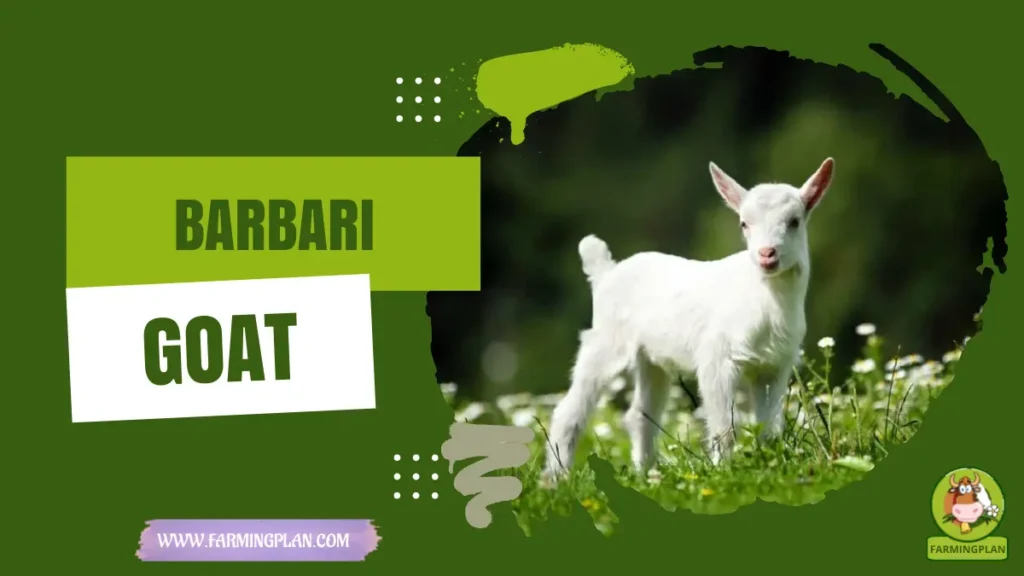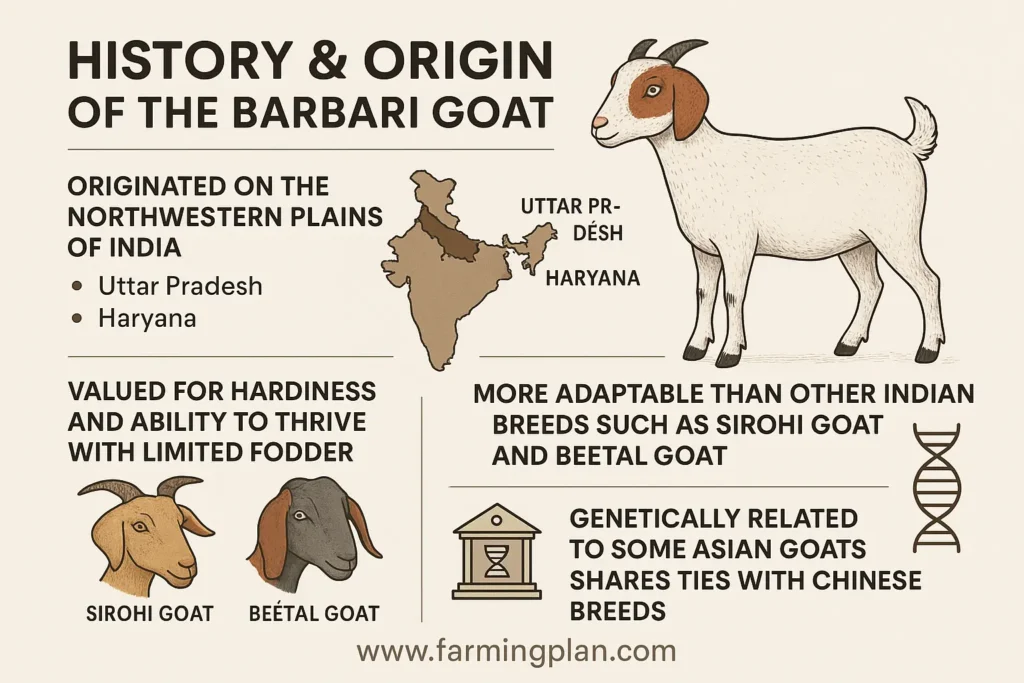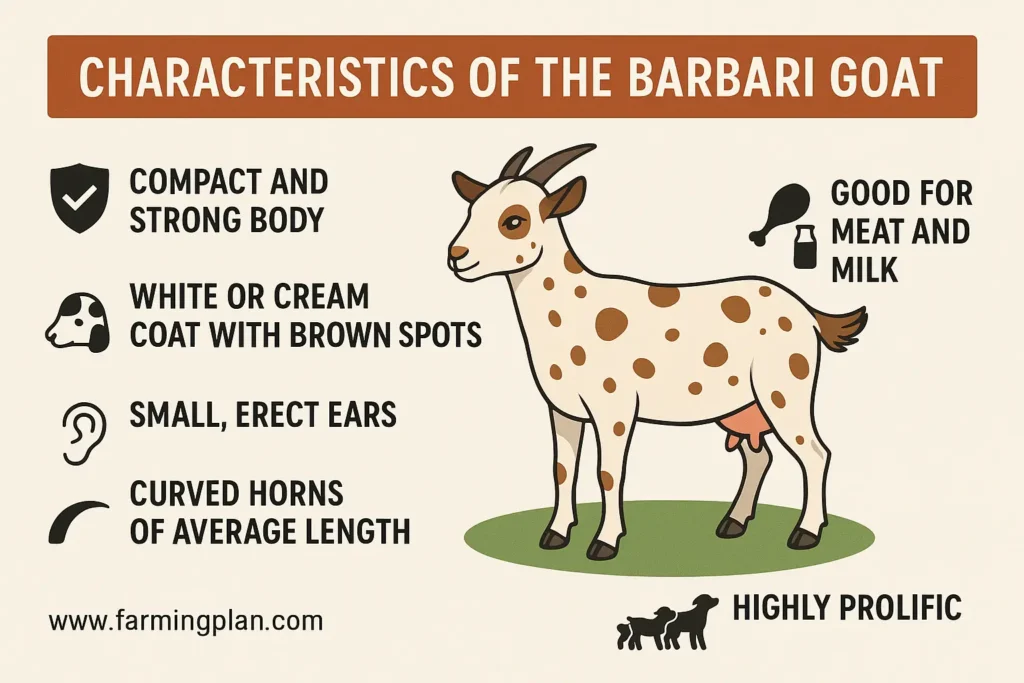If you’ve ever thought about adding a new breed to your farm or simply want to learn more about one of India’s most beloved goats, the Barbari goat should definitely be on your radar. Known for its compact body, impressive milk production, and hardy nature, the Barbari goat is a favorite among farmers, breeders, and animal lovers—especially in Uttar Pradesh where it originally comes from. In this guide, I’ll take you through everything you need to know about Barbari goats—from their origin and key traits to feeding, health care, and even where to find the best animals for sale. New or experienced, see why the Barbari goat fits any farm!

History & Origin of the Barbari Goat
The Barbari goat originated on the northwestern plains of India, mainly found in Uttar Pradesh and a section of Haryana. People have valued donkeys for hundreds of years, both for what they can do and how tough they are. Farmers in these regions favored Barbari goats for their ability to thrive even when fodder was limited—a true survivor! Compared to other Indian breeds like the Sirohi goat or the Beetal goat, Barbari stands out for its adaptability and consistent performance. Interestingly, it’s closely related to some Asian goats and even shares genetic ties with Chinese goat breeds, highlighting the diversity of goat germplasm in this part of the world.

Historically, the Barbari goat was also part of various conservation and breeding programs led by institutions like the Department of Animal Breeding & Genetics. These efforts were aimed at preserving its genetic makeup and improving milk production and growth rates without losing its hardiness. Thanks to these programs, the Barbari goat remains one of the classified breeds protected under FAO Animal Production and Health initiatives. It’s fascinating how this goat carries centuries of heritage while adapting well to modern farming needs.
If you think of Barbari goats, you’re picturing a breed with an interesting past and a solid reputation among farmers across India and beyond. The special quality of the Barbari goat comes from the way its heritage meets its practical uses.
Characteristics of the Barbari Goat
We’ll look at what sets the Barbari goat apart from others when it comes to its appearance. With a compact and strong body, these goats are designed to do well in all types of conditions. Most of the time, their coat is white or cream and has clear brown spots or patches, making them easily recognizable. The ears are quite small and stand upright and the average horns are curved and not too long. Farmers love this size because they can have many goats in less area but the goats remain productive.

It is also interesting to notice the genetics of Barbari goats. Researchers use DNA found in blood samples to discover special markers that set this breed apart. For anyone breeding to maintain the purity of a breed or to change specific traits such as milk yield or resistance to disease, these markers are important. Barbari goats bring together good traits for meat, milk and toughness, unlike Teddy Barbari and Swiss goats.
Barbari goats are known for having the ability to produce multiple offspring each birth, making them special. Because of this, farmers count on them to quickly build their herd. In addition, their height and well-built bodies let them provide breast milk, as well as meat, making them ideal in any goat farming operation.
Read More: Boer Goat: Secrets to Starting a Successful
Nature and Temperament
If you’re wondering what it’s like to live with or care for a Barbari goat, you’re in for a treat. These goats are known for being friendly, docile, and relatively easy to handle, which is why they’re often recommended for small-scale farmers and hobbyists. They’re not the type to cause trouble or be overly skittish, which makes daily handling and health checks much easier. Their calm temperament also makes them suitable for mixed farming setups where they might share space with other animals.

Barbari goats are curious and social, enjoying interaction with their caretakers, which helps build a bond over time. This makes them great pets or show animals if you’re interested in that. Their behavior contrasts nicely with some of the more temperamental breeds, making them ideal for beginners or families interested in goat farming. I’ve personally found that Barbari goats quickly warm up to you, especially if you’re consistent with feeding and care routines.
They’re also quite adaptable to different environmental conditions, from the hot summers of Uttar Pradesh to more temperate zones. This adaptability extends to their diet and health needs, making them forgiving if your fodder supply isn’t always perfect. Overall, their gentle nature combined with practical hardiness makes the Barbari goat a favorite among many.
Food and Diet Requirements
Feeding your Barbari goats right is key to unlocking their full potential in milk and meat production. These goats thrive on a mix of green fodder and dry fodder straw, which should be conserved properly to last through leaner months. Adding a bit of blood meal can boost their protein intake, which is crucial for growth and reproduction, especially if you’re aiming for those famous triple kidding results.
One neat tip from my experience: incorporating iodine or tincture iodine supplements can work wonders for their health. Iodine supports thyroid function and immune health, and given that many rural areas might have iodine-deficient soil, this little addition can keep your goats in tip-top shape. Just be sure not to overdose; balance is everything.
Avoid overfeeding grains or high-starch foods as Barbari goats are built for efficient, sustainable digestion. Also, steer clear of sudden diet changes to prevent digestive upsets. Remember, the best diet mimics their natural grazing habits as closely as possible—good quality roughage plus occasional protein boosts. Keep water fresh and plentiful because hydration is just as important as feed quality.
Read More: Why Kiko Goats Are Perfect For Your Farm
Usage and Purpose of Barbari Goats
Barbari goats are pretty much the Swiss Army knives of the goat world. They offer great milk production, decent meat yield, and breed well, making them a multi-purpose asset for any farm. Farmers in Uttar Pradesh and neighboring states especially love Barbari goats because they can juggle all these roles while being low-maintenance.
Milk from Barbari goats is nutritious and often used locally for fresh consumption or making dairy products. But it’s their meat quality that also draws many breeders; it’s tender and flavorful, ideal for markets where goat meat is a staple. The fact that Barbari goats reproduce well—often having twins or triplets—means you can grow your herd quickly, which is excellent for income generation.
The Barbari goat market is active, and you’ll find many farmers selling and buying these goats online and offline. Whether you’re a breeder looking to improve your herd or a farmer wanting to diversify your livestock, Barbari goats are a smart choice. Plus, selective breeding with Barbari can help improve other breeds, contributing to the overall improvement of goat breeds in the region.
Special Features of the Barbari Goat
What sets Barbari goats apart isn’t just their looks or productivity—it’s the unique blend of qualities packed into one small package. First up, their compact body makes them easy to house and care for. They’re also known for being prolific breeders, often giving birth to twins and even triplets, which is a boon for anyone wanting to expand their herd fast.
Another cool feature is their genetic diversity. Barbari goats have been part of conservation strategies under programs like the FAO Animal Production and Health Paper 30. These strategies focus on preserving the breed’s valuable traits while preventing genetic erosion, ensuring Barbari goats remain robust for generations to come.
They’re also quite hardy, resisting common diseases better than many other breeds. This hardiness, combined with their adaptability to different climates and fodder types, makes them reliable companions on farms. In short, Barbari goats are a versatile, tough, and productive breed that offers farmers a wide range of benefits.
Read More: Alpine Goat: Smart, Hardy & Milk-Rich Breed
Health Issues and Prevention
Like any livestock, Barbari goats face some health challenges, but many problems are preventable with proper care. Common issues include parasitic infections, respiratory problems, and nutritional deficiencies. If you notice your goats looking dull, coughing, or having diarrhea, it’s time to act quickly.
A good vaccination schedule and regular deworming will keep most diseases at bay. I always recommend monitoring for signs of infection early—if a goat looks off or refuses feed, don’t wait. Using supplements like iodine helps prevent common mineral deficiencies that can weaken their immune system.
Clean housing and proper hygiene are your best friends here. Keeping their living area dry and free of manure reduces infection risk significantly. Also, routine health checks and maintaining good blood markers through regular vet visits help keep your herd strong. Remember, a healthy goat is a happy and productive goat!
“The strength of a farm lies not just in the land it owns, but in the resilience of the animals it nurtures. The Barbari goat is proof that small stature can hold immense value.”
Step-by-Step Farming Guide for Barbari Goats
Step 1: Setting Up the Right Environment
Start by building a clean, well-ventilated shelter that protects your goats from harsh weather but allows fresh air. Make sure there’s enough space for each animal to move comfortably without overcrowding. A dry floor with proper drainage is essential to prevent infections.
Step 2: Feeding Your Goats
Provide a balanced diet including green fodder, conserved fodder, and dry straw. Supplement with blood meal and iodine if possible. Make feeding times regular and ensure fresh water is always available.
Step 3: Breeding and Reproduction
Keep track of breeding cycles and aim to mate your does at the right time to maximize kidding success. Monitor pregnant goats closely, and prepare a quiet, safe space for births. Expect twins or triplets, which is a great sign!
Step 4: Daily Care and Health Checks
Spend time each day observing your goats. Check for signs of illness or distress, clean their living area, and maintain feeding schedules. Regular grooming helps spot issues early and strengthens your bond with the animals.
Expert Tips & Best Practices
- Always source your Barbari goats from reputable breeders who can provide health and genetic records.
- Use genetic markers and alleles size info to select the best breeding stock.
- Keep iodine supplementation consistent, especially in regions prone to deficiencies.
- Maintain a diverse gene pool by occasionally introducing animals from related breeds like Sirohi or Beetal to avoid inbreeding.
- Monitor milk yield and kid growth regularly to catch any problems early.
Where to Buy Barbari Goats
If you’re ready to bring Barbari goats to your farm, your best bets are livestock markets in Uttar Pradesh and nearby states. Many breeders also list goats online, but always check for health certificates and genetic background before purchasing. Price varies depending on age, sex, and quality, but expect a moderate investment for top-quality stock. Don’t hesitate to visit farms personally or ask for references to ensure you’re getting healthy animals.
FAQ
What is the origin of the Barbari goat?
The Barbari goat originates from northern India, especially Uttar Pradesh and parts of Rajasthan. It is well-known for its adaptability to the local climate and farming conditions.
What are the main characteristics of the Barbari goat?
Barbari goats are medium-sized with a compact body and distinctive brown patches. They are famous for their high milk production, hardiness, and ability to give birth to twins or even triplets.
How do I care for Barbari goats?
Providing balanced fodder, clean water, and regular health check-ups is key. Barbari goats thrive on dry fodder straw and conserved fodder. Also, maintain proper hygiene and vaccination schedules to prevent diseases.
Are Barbari goats good for meat production?
Yes, Barbari goats produce quality goat meat. Their medium size and good growth rate make them suitable for both milk and meat farming.
Where can I buy Barbari goats?
You can find Barbari goats for sale at local farms in Uttar Pradesh, Rajasthan, and livestock markets. Some breeders also offer Teddy Barbari goat hybrids, which combine traits from Barbari and Teddy goat breeds.
Conclusion
Raising Barbari goats has been a rewarding experience for me, especially because of their hardy nature, compact body, and excellent milk production. Whether you’re a farmer looking to expand your herd or a hobbyist interested in raising goats, the Barbari goat offers a great balance of productivity and ease of care. By understanding their origin, characteristics, diet, and health needs, you can provide the best environment for these amazing animals to thrive. Remember, good care and attention to their unique traits will make all the difference in your goat farming success!

